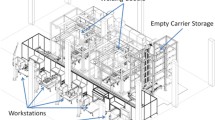Abstract
The main objective of this paper consists on presenting an application of The Hodgson’s manufacturing scheduling algorithm applied on a production system model, through simulation technique. The simulation, executed on Arena, is applied to a model of a production environment for producing three new products, by using five different components. The components are processed on several work centres, which include different machines, organized on a job shop environment. The Hodgson’s algorithm is applied on a particular machine of the job shop, which consists on a bottleneck, and the main objective consists on minimizing the total number of tardy jobs on that bottleneck machine.
Access this chapter
Tax calculation will be finalised at checkout
Purchases are for personal use only
Similar content being viewed by others
References
Kelton WD, Randall RP, Sturrock DT (2004) Simulation with arena. McGraw-Hill, New York
Koh K, Souza R, Ho N (May 1995) Direct database-simulation of a job-shop. Int J Prod Econ 39(3):281–287
Almeida MS et al (2006) Utilização da simulação em ARENA 7.0 no auxílio do balanceamento da célula de montagem de uma fábrica de calçados. In: XXVI ENEGEP, Fortaleza, Brasil
Armentano VA, e Ronconi DP (2000) Minimização do tempo total de atraso no problema flowshop combuffer zero através de busca tabu. Gestão e Produção 7(3):352–363
Baker KR (1974) Introduction to sequencing and scheduling. Wiley, New York
Vinod V, e Sridharan R (2009) Simulation-based metamodels for scheduling a dynamic job shop with sequence-dependent setup times. Int J Prod Res 47(6):1425–1447
Wang J-B (2008) Single-Machine scheduling with past-sequence-dependent setup times and time dependent learning effect. Comput Ind Eng 55:584–591
Acknowledgements
The authors wish to acknowledge the support of: (1) The Foundation for Science and Technology—FCT, under the scope of the financed Project on “Ubiquitous oriented embedded systems for globally distributed factories of manufacturing enterprises”—PTDC/EME-GIN/102143/2008, and (2) EUREKA, under the Project E!4177-Pro-Factory UES.
Author information
Authors and Affiliations
Corresponding author
Editor information
Editors and Affiliations
Rights and permissions
Copyright information
© 2014 Springer Science+Business Media Dordrecht
About this paper
Cite this paper
Pinto, T., Varela, L. (2014). A Manufacturing Scheduling Approach by Combining Simulation Technique with the Hodgson’s Algorithm. In: Fonseca Ferreira, N., Tenreiro Machado, J. (eds) Mathematical Methods in Engineering. Springer, Dordrecht. https://doi.org/10.1007/978-94-007-7183-3_23
Download citation
DOI: https://doi.org/10.1007/978-94-007-7183-3_23
Published:
Publisher Name: Springer, Dordrecht
Print ISBN: 978-94-007-7182-6
Online ISBN: 978-94-007-7183-3
eBook Packages: EngineeringEngineering (R0)




